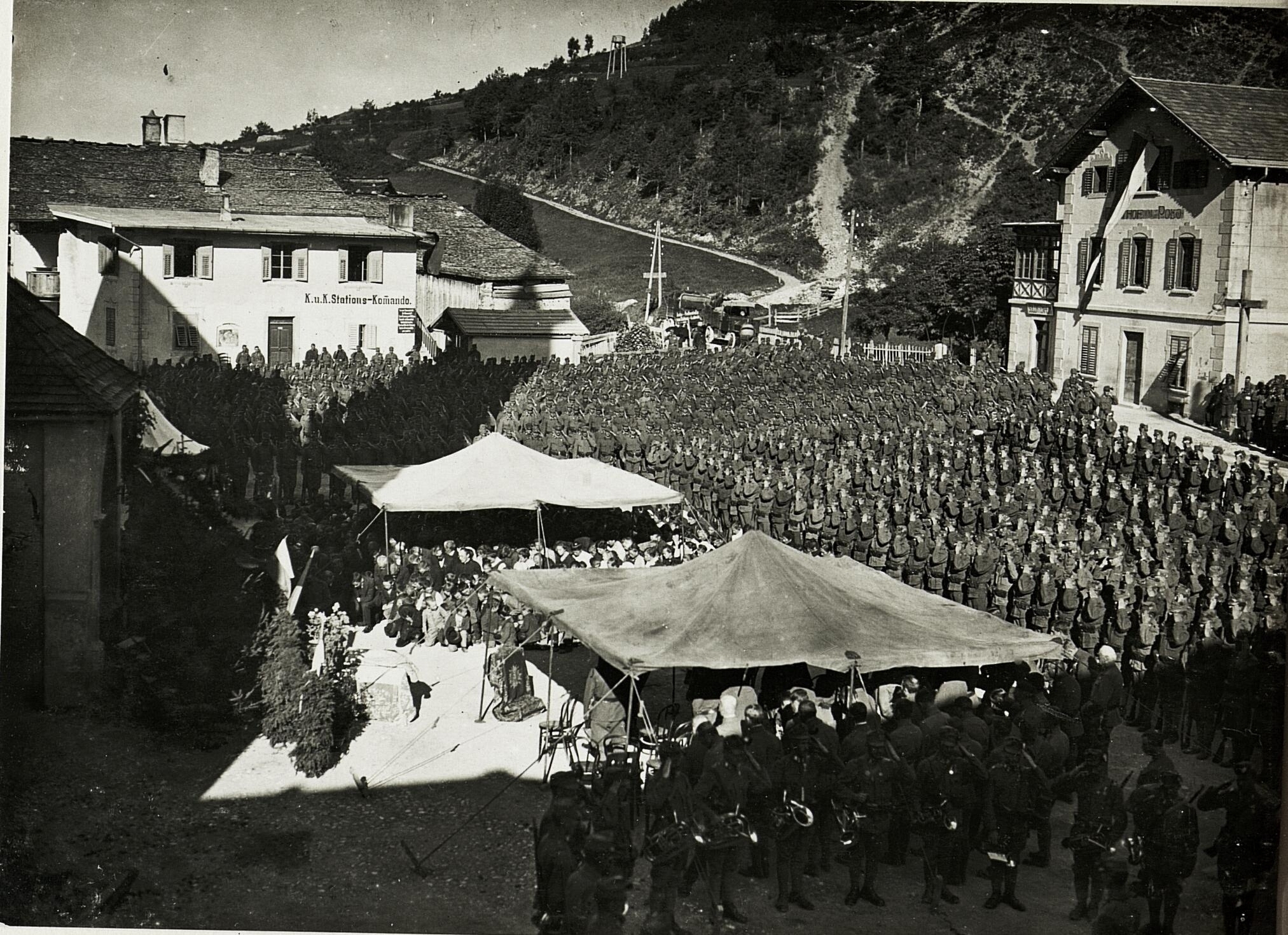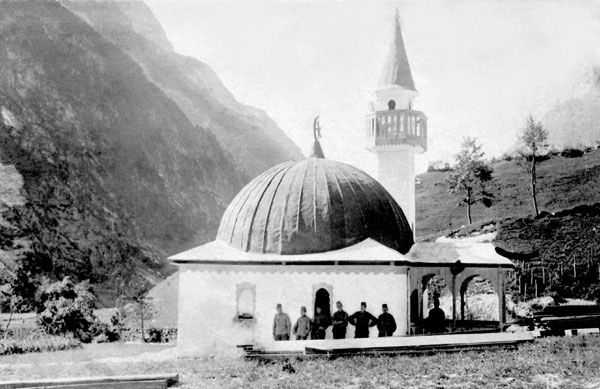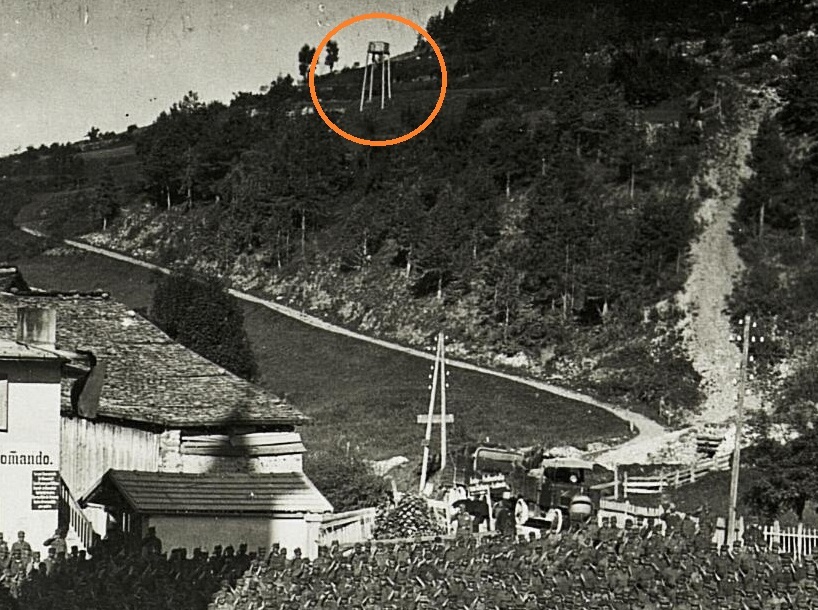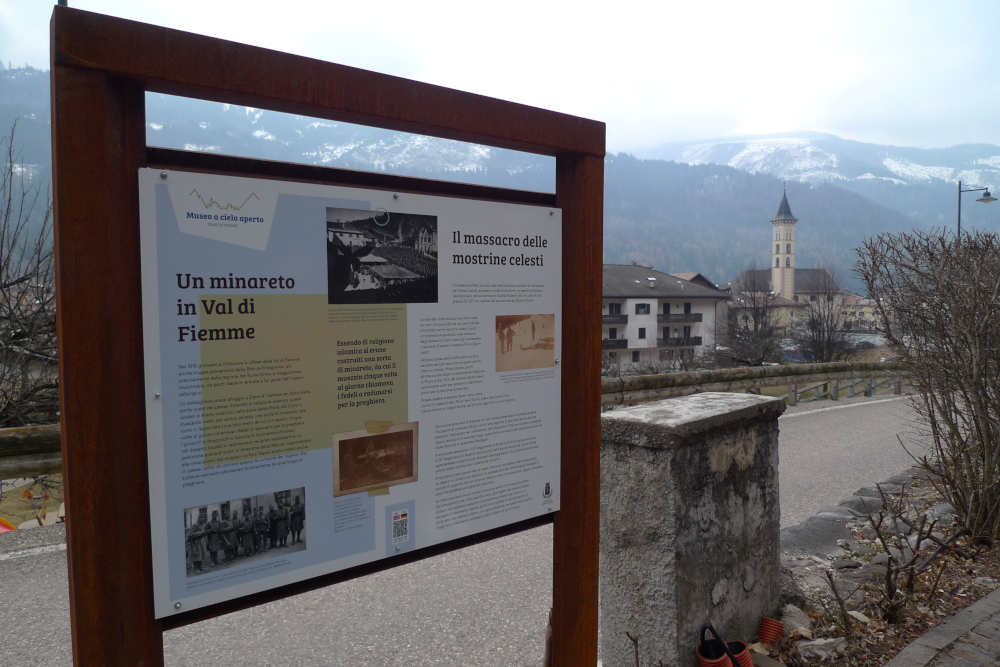
Ziano di Fiemme, August 1917. Copyright Bildarchiv der Österreichische Nationalbibliothek
Thousands of Bosnian soldiers served in the Austro-Hungarian ranks during the First World War. Now a project uncovers and recounts their traces in Trentino
Anyone strolling around the village of Ziano di Fiemme, nestled in one of the charming valleys of the Dolomites, would easily come across a rather unusual vestige. Starting from 2021, the public signage installed by the municipality - aimed at creating an authentic Open-Air Museum - among the episodes of the First World War recalls the presence in the village of soldiers from Bosnia and Herzegovina. Above all, it reveals to the visitor the existence of a minaret, located a few hundred meters from the church, built to meet the needs of the Muslim soldiers.
The tragic years of the First World War also represented a period of new encounters and cultural interactions. At the outbreak of the conflict, humanity was already on the move. For some decades the world was witnessing large migrations of masses of women and men embarking on journeys - often transoceanic - in search of better living conditions. The war imposed new forms of mobility. The initiatives of the authorities resulted in the transfer of millions of soldiers, while millions of civilians experienced displacement and deportation. In 1915, at the beginning of hostilities on the Alpine-Dolomite front, where Italy and Austria-Hungary confronted each other in a "white" and "vertical" war, tens of thousands of people were transferred from Trentino to the internal territories of the Habsburg Empire and, to a lesser extent, towards Italy.
At the same time, however, thousands of people from the eastern part of the continent, the Balkans, and the vast territories of the Tsarist Empire arrived in Trentino, already involved in the conflict. They were prisoners of war belonging to the armies fighting Austria-Hungary, but also soldiers and militarized workers assigned to the units of the Imperial Royal Habsburg Army. Among the encounters that have left the most significant traces in individual memories and those of local communities is certainly the one with the "Bosgnachi", as they were called in the local dialect, i.e. with the soldiers from Bosnia and Herzegovina.
The First World War of the Bosnians in Trentino
Bosnia and Herzegovina, for centuries an Ottoman province, was occupied by the Habsburg army in 1878, following the decisions taken at the Congress of Berlin. Then in 1908 Vienna decided to proceed with the effective annexation of Bosnia and Herzegovina. However, already in 1882 four Bosnian regiments were established and then merged into the imperial-royal armed forces. After the Sarajevo assassination and the outbreak of the conflict in the summer of 1914, Bosnians - as well as millions of their peers from Europe and beyond - ended up in the trenches of the Great War.
Bosnians were particularly recognizable among the Austro-Hungarian ranks by their uniforms, especially the fez. They also distinguished themselves as soldiers, obtaining various honors and awards. According to data reported in a well-articulated research by historian Zijad Šehić, full professor at the University of Sarajevo, 291,498 people were mobilized during the war in Bosnia and Herzegovina. The Austro-Hungarian forces included members of all religious and ethno-national communities present in the country, even if Orthodox Christians were considered potentially less reliable, considering the ongoing war against Serbia and various episodes of desertion, therefore they were employed with greater caution. The research reveals that the percentages could have been calibrated differently depending on the type of unit and whether it was a front-line, reserve or rear unit. A document presented by Šehić, dated March 1918, offers a comprehensive perspective, revealing that at that date among Bosnian war invalids there were 4,413 "Muslims", 5,371 "Orthodox", 2,586 "Catholics", 32 "Jews" and 356 "others". Data which, as Šehić points out, largely reflect the confessional structure of the population at the time.
Bosnian regiments were deployed by Austria-Hungary along the entire front with Italy. The engagement was consistent on the Isonzo front, but military reports also tell of important battles on the Alpine-Dolomite front. However, it is the testimonies of the population of the Trentino valleys that contribute most to understanding the movements and presence of Bosnian soldiers on the territory far from the trenches. It is certain that some units were quartered for many months in the valleys of Fiemme and Fassa, at the foot of the peaks along which the front line ran, which had arisen in the spring of 1915, shortly after the outbreak of hostilities.
The memoirs of Ziano di Fiemme
After the difficult adjustment phase following the occupation of Bosnia and Herzegovina, Vienna had tried to establish new relations with the Bosnian-Muslim landowners and intellectuals. After the annexation of 1908, the Habsburg administration granted the Islamic community autonomy in religious and educational matters. The soldiers' right to worship was guaranteed by the presence of military imams, whose number increased significantly during the conflict. According to the historical reconstructions made by various scholars, the construction of a mosque was discussed at length in Vienna itself. In 1916, on the Isonzo front, more precisely in Log pod Mangartom, a place of worship was built for Bosnian Muslim soldiers: today several photographs testify to the architecture of that mosque, destroyed after the end of the war.
It seems there were no buildings of similar characteristics and dimensions on the Trentino-Tyrolean front. However, traces of the presence of places of worship created for those same Bosnian soldiers have remained etched in the memory of some local communities. In Gardolo, today a populous suburb of Trento, often at the center of discussions on the integration of the immigrant population, various testimonies from the 1980s, concerning the presence of "rudimentary wooden minarets", have been recalled more than once in the public debate.
In Ziano di Fiemme for decades now there has been talk of the existence of a minaret. For example, Candido Degiampietro, teacher of the local school, who was a child during the war, wrote about it in 1986, recalling: "All the inhabitants of the villages crossed by the Bosnians had come to see those soldiers in strange uniforms who instead of the usual Austrian military cap (die Mütze) wore an unusual gray headdress: the 'fez' of the Muslims […] The Bosnians were tall men, almost gigantic who, camped in Ziano, immediately erected a wooden minaret from which, three times a day, their 'muezin' was launching the invitation to prayer, arousing the amazement of the population that seemed to be transported to another world”. (mistakes in the original quote)
In 1993, Aldo Zorzi, a passionate connoisseur of local history, narrated the curiosity, caution, and humanity traced in the stories of the last witnesses of those meetings. Also another testimony, characterized by unsympathetic tones towards the Habsburg multiculturalism - which appeared in 1929 in an important Trentino magazine - confirmed the existence of a religious structure: "In the spring of 1916 we saw troop after troop pour in, a motley mass of Germans, Serbs, Croats, Galicians, and Ruthenians. It was then that Ziano saw a minaret rise not far from the church. The mass of soldiers penetrated into all houses, into all environments, with a repugnant promiscuity detrimental to any moral sense. The consequences were not irreparable only thanks to the firm religious and moral principles of that people”.
According to data collected at the time by Aldo Zorzi, the minaret would have been built in the "Parti del Cioto" area, in the westernmost part of Ziano. The public signage recently set up in the village shows a photograph found in the archives of the Austrian National Library: the image bears witness to the presence of a very unusual vertical structure in the aforementioned location. Walter Zorzi, one of the local enthusiasts who helped track down the document, reveals that a photograph of the minaret had appeared in an exhibition way back in 1976. “This impressed me a lot. Following this memory of mine, in the following years I was able to view the photograph from the Austrian archive showing a ceremony held on the birthday of the Austrian emperor in Ziano’s square in August 1917 where in the background of the photograph it is still possible to glimpse that tower that I had the opportunity to see in the first circumstance, many years before”. Although characterized by very different forms from those of traditional Muslim architecture, it really seems to be the Bosnian minaret.
Experiences rediscovered
"Some things I already knew, others I found in dad's writings, so I was invited to be part of a committee which, together with the cultural association 'Ziano Insieme', managed the creation of the open-air museum itinerary […] which traces the history of Ziano from its origins to the 1970s, with the transformation from agricultural to tourist economy”, says Carlo Zorzi, Aldo’s son, explaining the collective effort that supported the project. Ziano di Fiemme certainly represents an interesting example of inclusion of encounters dating back to the years of the First World War in a broader narration of the territory promoted by the community. As in the case of the prisoners of war of the Russian and Serbian armies, the memory of the Bosnian soldiers has also been preserved for a long time above all in toponymy and popular memories. For years the only exception was a small monument in Italian, Bosnian and German, positioned in 1996 on Mount Fior (Melette), on the Asiago plateau, as a testimony of a bloody battle fought during the Austro-Hungarian offensive in the spring of 1916.
Therefore, the very rich public memory of the conflict, open and inclusive of the various experiences of the local population, gradually began to recognize the importance of the role that the "other" presences had in shaping the overall experience of the war. OBCT, in partnership with Italian War History Museum, Deina Trentino and Viaggiare i Balcani, and in collaboration with Extinguished Countries, has launched a new project aimed at continuing efforts in this direction, recounting the experiences of encounters that the First World War had brought to a territory devastated by the conflict such as Trentino. Stories that reveal moments of difficulty and tension, but also episodes of cultural contamination and solidarity. We will be back soon with more news.
Publication produced as part of the project "The Great War: Europe in Trentino and the encounter with the Other", supported by the Caritro Foundation




















 To Top
To Top